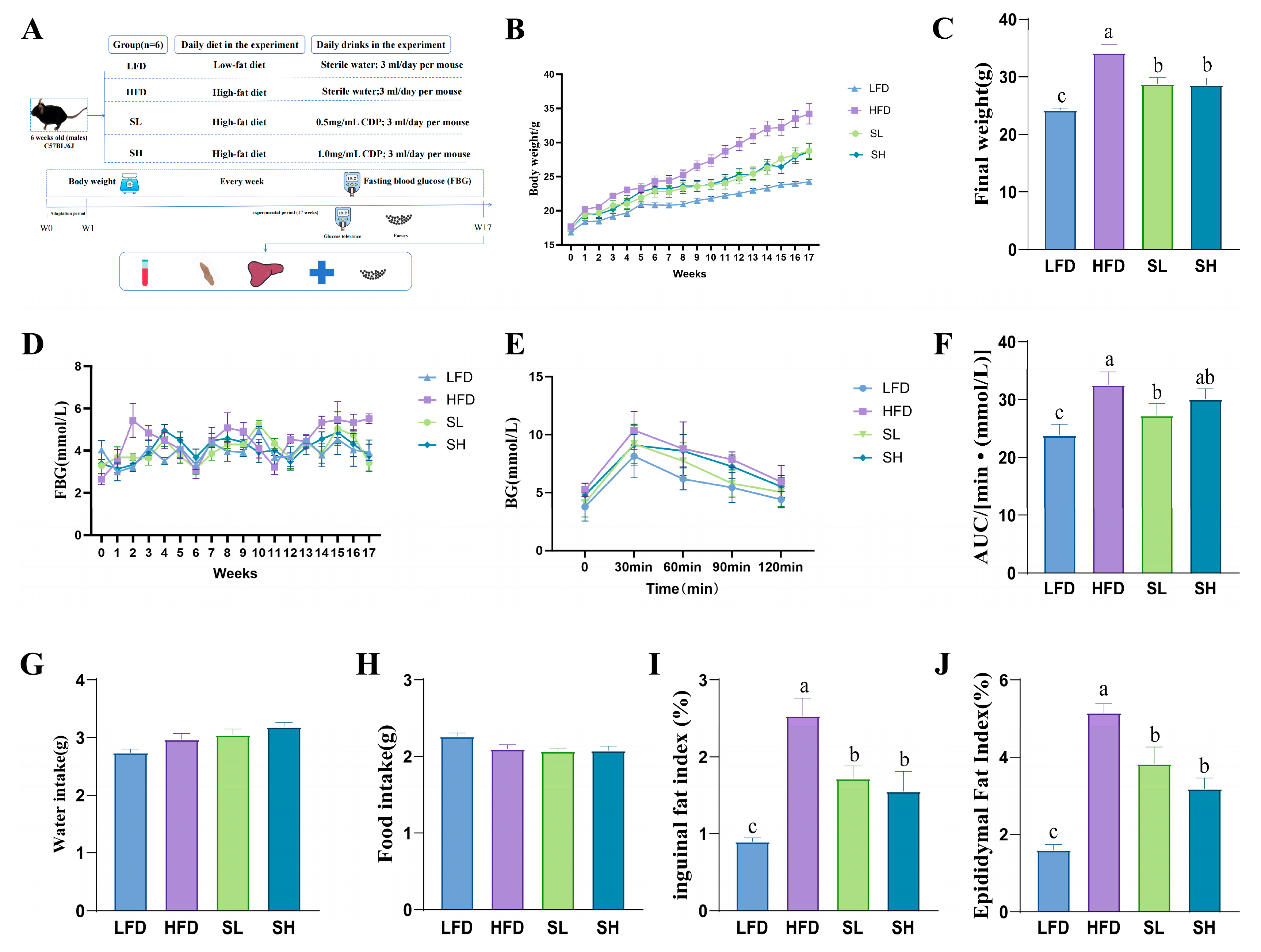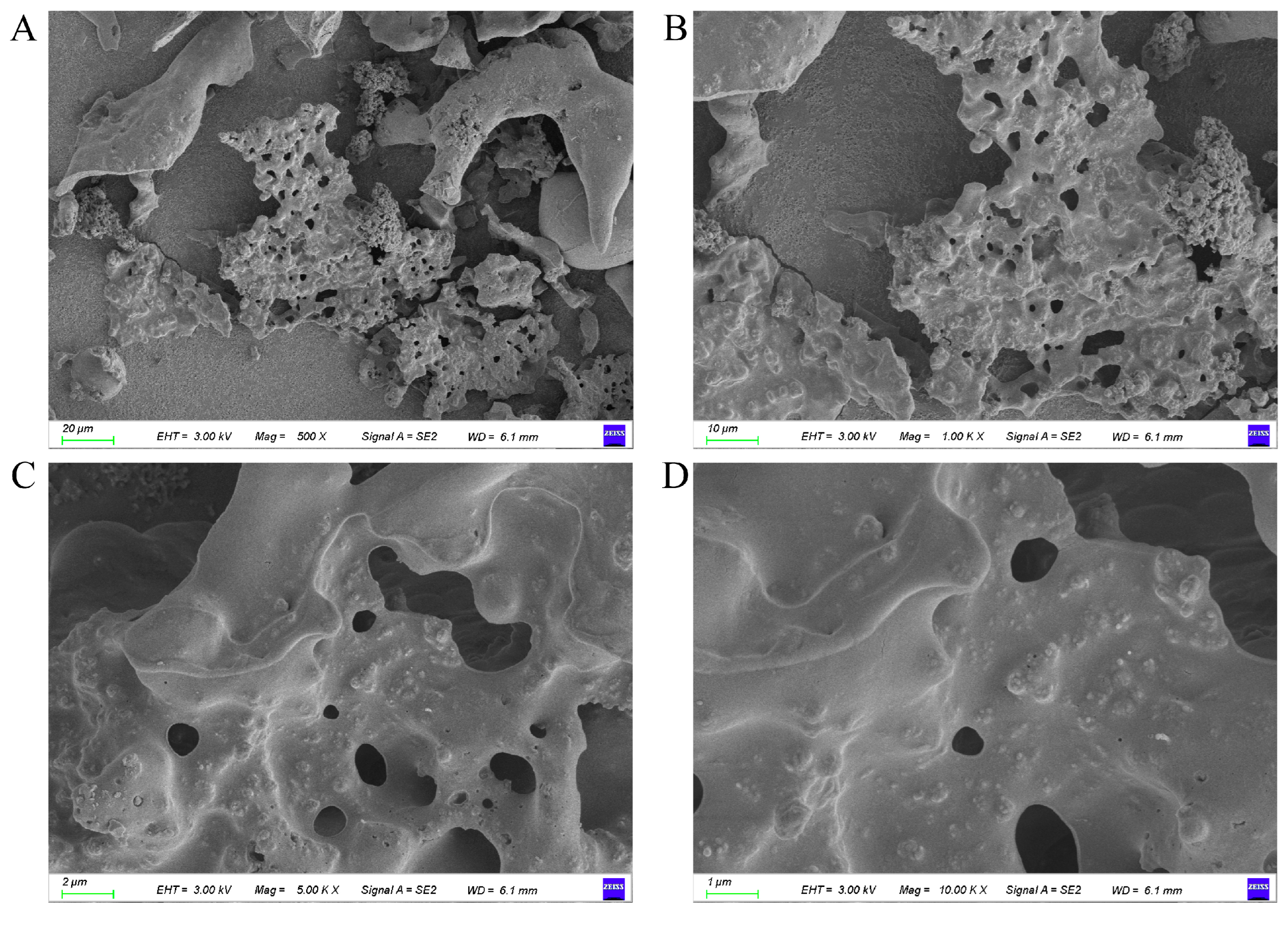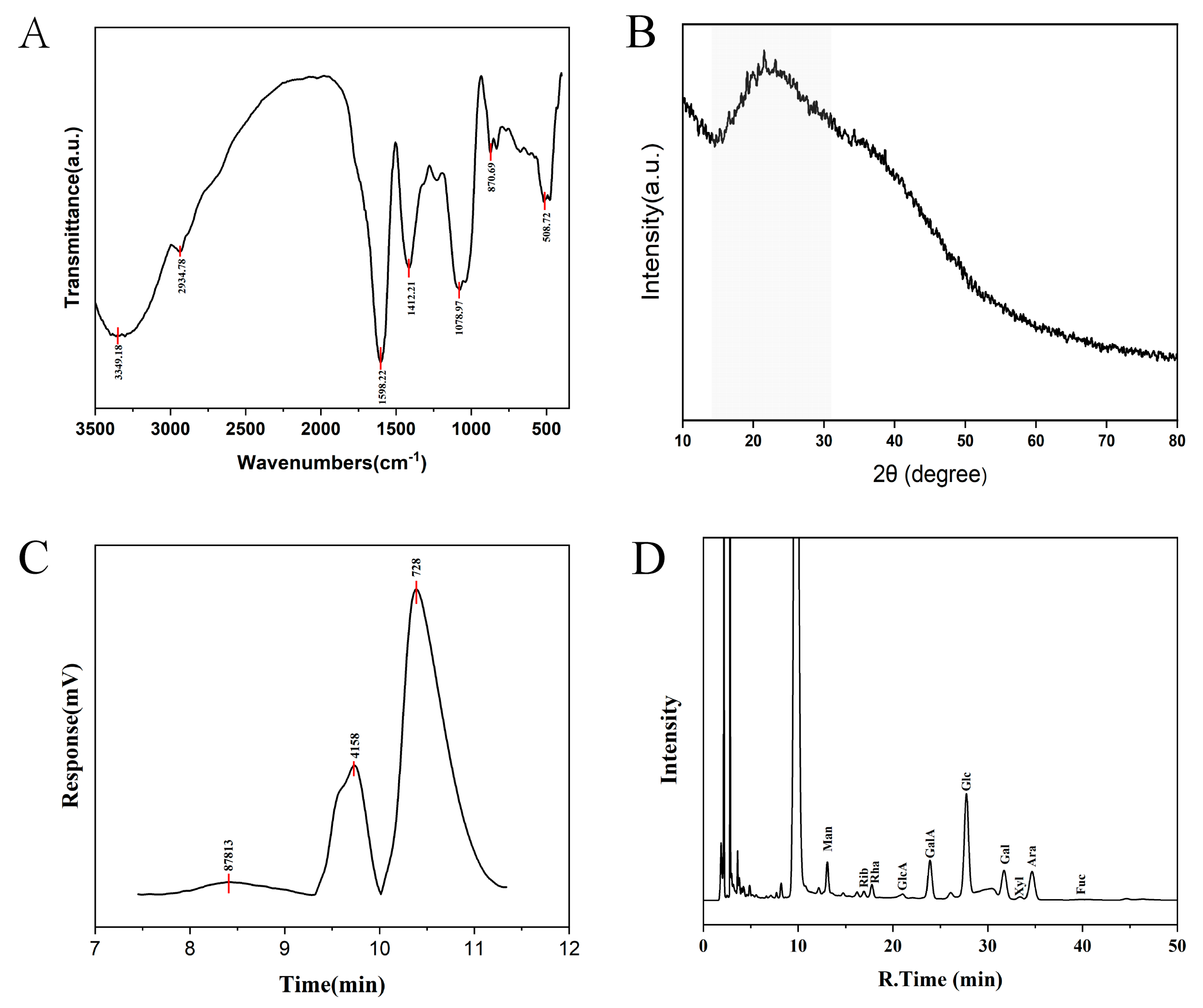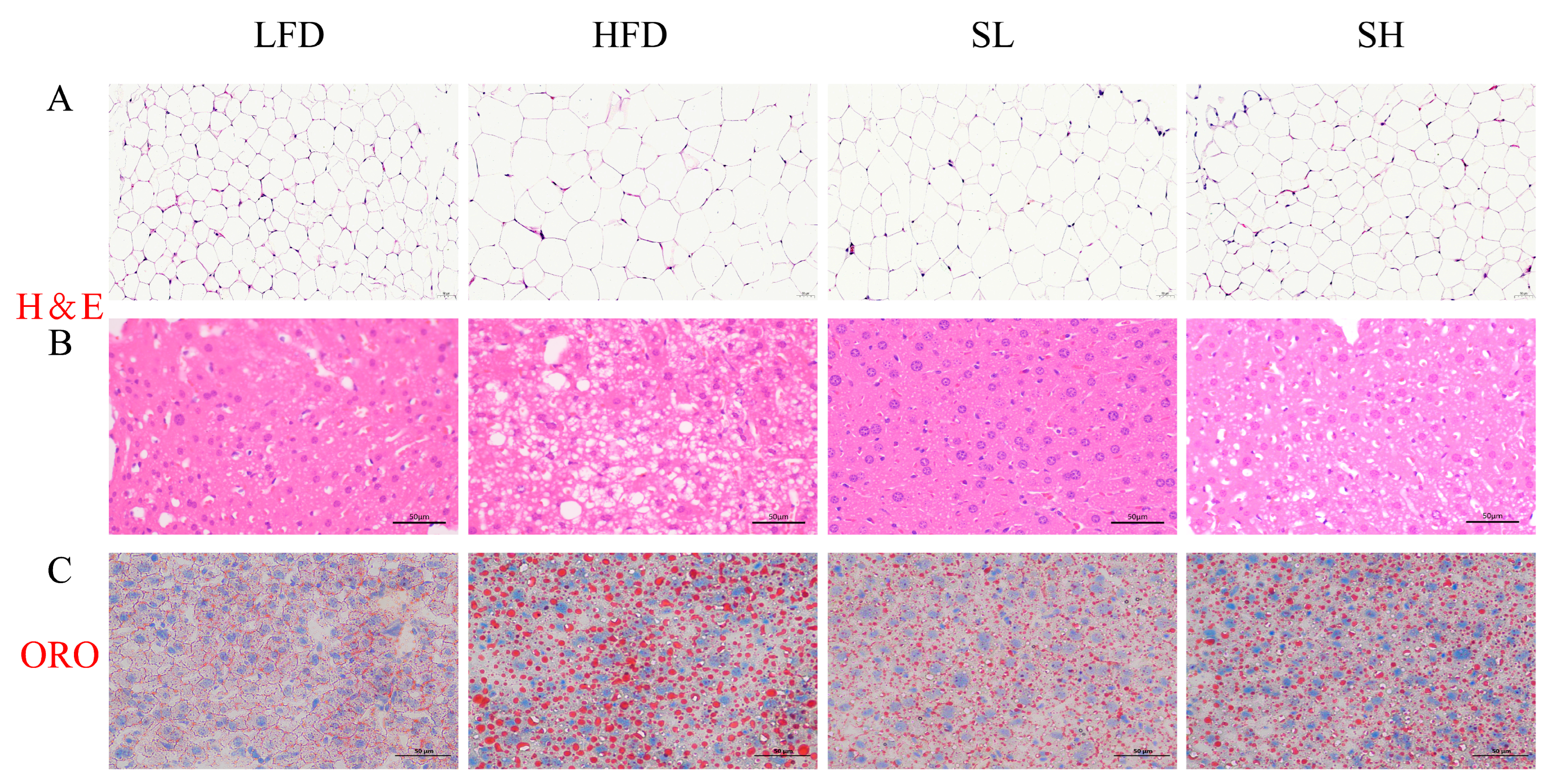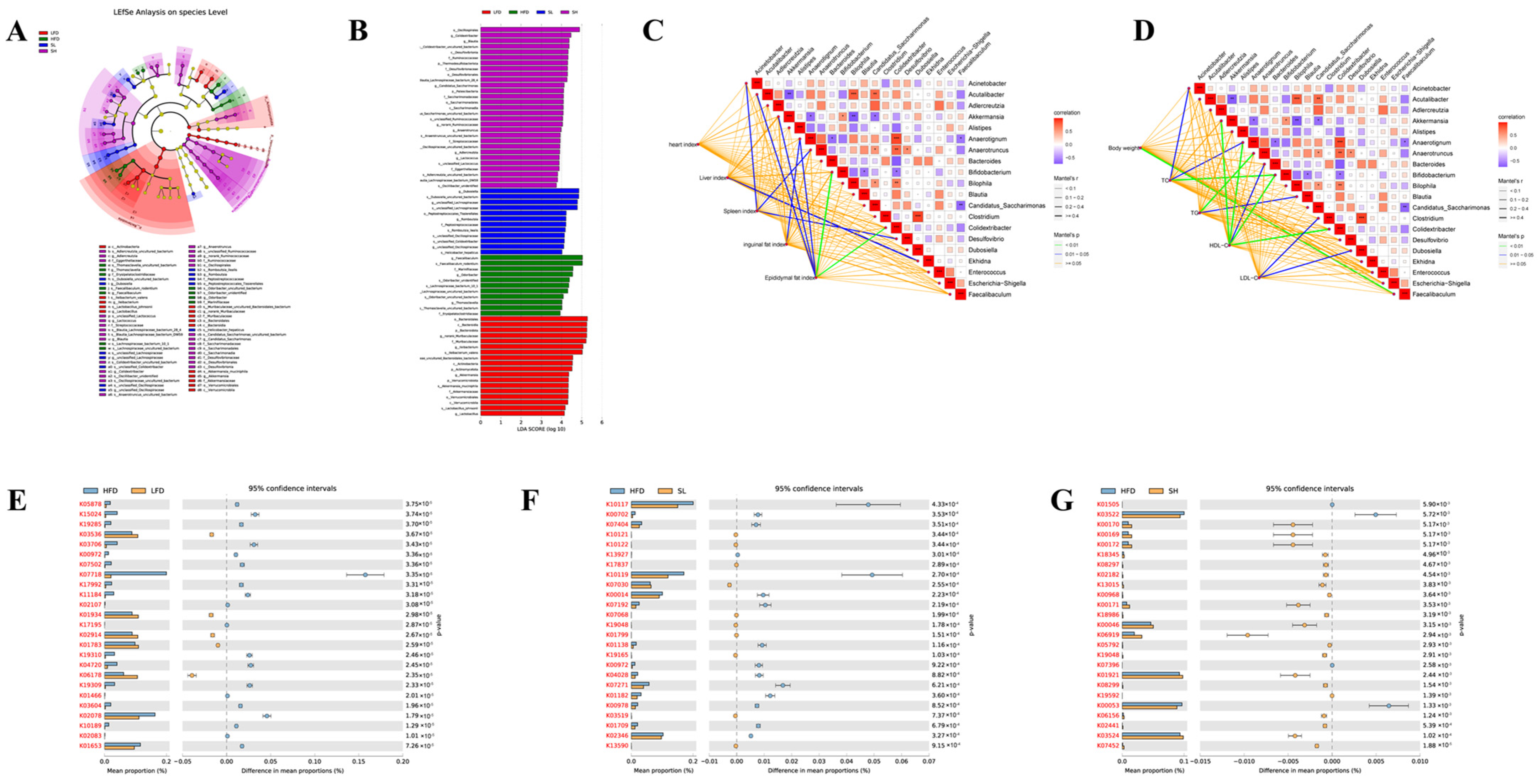1. Introduction
Obesity, a metabolic disorder of increasing prevalence, has become a major global health challenge. It is characterized by pathological adipose accumulation and systemic metabolic dysregulation and is associated with increased risk of multiple comorbidities. Recent epidemiological data indicate substantial increases in obesity-associated conditions, including type 2 diabetes mellitus, cardiovascular disease, hypertension, and obstructive sleep apnea [
1,
2]. The primary driver of obesity is chronic energy imbalance, in which energy intake persistently exceeds expenditure, leading to ectopic lipid deposition across multiple tissues [
3]. Although genetic background and endocrine disorders confer susceptibility, the principal modifiable determinants are sustained consumption of energy-dense diets and physical inactivity/sedentary behavior.
Individuals with obesity commonly exhibit reduced intestinal microbial diversity, characterized by lower abundances of putatively beneficial commensals, increased pathobiont taxa, and altered microbial metabolites. Such dysbiosis may further exacerbate host metabolic dysregulation, creating a self-reinforcing cycle. Accordingly, modulation of gut microbiota structure and function is increasingly recognized as a therapeutic strategy for obesity and related metabolic complications. Consistent with this concept, numerous studies have shown that bioactive natural extracts ameliorate high-fat diet (HFD)-induced obesity in murine models, at least in part by modulating the gut microbiota. Reported examples include
Ganoderma amboinense polysaccharide [
4], Caffeic acid [
5], and Allicin [
6].
Coral dealbatus is a functional vegetable cultivar developed by the Chinese Academy of Agricultural Sciences via interspecific hybridization between the rare wild Feicai (
Sedum aizoon L.) and Jingtian Sanqi (
Gynura japonica). This hybrid is primarily adapted to, and cultivated in, northern, central, and eastern China. Despite its agronomic potential, commercial cultivation remains limited, and existing research focuses mainly on agronomic practices and postharvest processing, with relatively few studies addressing its pharmacological properties [
7]. Polysaccharides are natural biomacromolecules extractable from diverse sources, including plants [
8], and they exhibit a broad spectrum of biological activities [
9]. For example, polysaccharides from
Acanthopanax ameliorate alcoholic fatty liver by regulating the gut–liver axis [
10]; pumpkin polysaccharides display antidiabetic effects in type 2 diabetic rats [
11];
Auricularia auricula polysaccharides alleviate non-alcoholic fatty liver [
12],
Poria cocos polysaccharides exert immunomodulatory effects; and ginger polysaccharides show anti-fatigue activity [
13].
Coral dealbatus crude polysaccharides (CDP) refer to the crude polysaccharide fraction extracted from
Coral dealbatus. However, it remains unclear whether CDP can attenuate fat accumulation in mice fed a high-fat diet (HFD).
Coral dealbatus is a plant with recognized medicinal and nutritional value and substantial potential for research and development. Reported bioactive constituents include marigold glucosides, oleanolic acid, and flavonoids. In traditional medicine, the plant is attributed with functions such as “nourishing the heart and liver,” “promoting blood circulation,” and “clearing heat and toxins”; contemporary studies further suggest potential benefits in the prevention and management of cardiovascular and cerebrovascular conditions. As a nutritious vegetable, Coral dealbatus can be processed into a variety of products with considerable market potential. From an economic perspective, large-scale cultivation may increase farmers’ income. The species also exhibits broad environmental adaptability and has been considered for agricultural production and ecological restoration. Reflecting these considerations, Coral dealbatus has been cultivated on a large scale in Nujiang Prefecture, Yunnan Province (China), as part of poverty alleviation programs, where it contributes to local household income. Nevertheless, peer-reviewed studies on Coral dealbatus remain limited and have focused primarily on cultivation and post-harvest practices, leaving its biological activities and functional properties under-investigated. Building on preliminary work, we extracted crude polysaccharides from Coral dealbatus (CDP) and evaluated their effects on obesity in high-fat diet (HFD) fed mice and on the gut microbiota, with the aim of addressing this knowledge gap and informing value-added utilization relevant to regional development.
In this study, crude polysaccharides from Coral dealbatus (CDP) were obtained by hydroalcoholic extraction followed by ethanol precipitation. We established a high-fat diet (HFD)-induced murine model of obesity to evaluate the effects of CDP on metabolic and histological endpoints relevant to diet-induced obesity. This work is intended to provide a preclinical basis to inform the development of CDP-based functional ingredients and related natural products.
2. Materials and Methods
2.1. Materials and Reagents
Dried Coral dealbatus material was purchased from Lushui Jianglin Poverty Alleviation Professional Cooperative (Lushui, Yunnan, China). Assay kits for total cholesterol (TC), triglycerides (TG), high-density lipoprotein cholesterol (HDL-C), low-density lipoprotein cholesterol (LDL-C), alanine aminotransferase (ALT), aspartate aminotransferase (AST), and bicinchoninic acid (BCA) protein quantification were purchased from Nanjing Jiancheng Bioengineering Institute (Nanjing, Jiangsu, China).
2.2. Preparation of CDP
CDP was prepared according to a published method with minor modifications [
14]. Briefly, dried
Coral dealbatus material was milled to a fine powder and extracted with deionized water at a material-to-liquid ratio of 1:10 (
w/
v) in three successive batches (30 min each), and the three filtrates were combined and concentrated. Absolute ethanol was then added to a final concentration of 70% (
v/
v). The mixture was kept at 4 °C overnight (~12 h) to precipitate polysaccharides, and the resulting precipitate was collected. The precipitate was redissolved in deionized water, deproteinized by the Sevag method (chloroform/n-butanol = 4:1,
v/
v), and lyophilized to obtain CDP.
2.3. Determination of Physicochemical Indexes of CDP
The total carbohydrate content of CDP was determined by the phenol–sulfuric acid method [
15], protein content was measured using the bicinchoninic acid (BCA) assay; total flavonoid content was quantified according to SN/T 4592-2016 [
16]; and total phenolic content was determined according to T/NAIA 097-2021 [
17].
2.4. Preliminary Characterization of CDP
2.4.1. Electron Microscope Scanning
Samples were mounted on metal stubs, sputter-coated with a thin gold film, and imaged using a scanning electron microscope (GeminiSEM 360, Zeiss, Obercohen, Germany).
2.4.2. Infrared Spectral Analysis and X-Ray Polycrystalline Diffraction Analysis
CDP powder was intimately mixed with spectroscopic-grade potassium bromide (KBr), finely ground, and pressed into pellets. Spectra were analyzed on a Fourier transform infrared (FT-IR) spectrometer (IRTracer-100, Shimadzu, Kyoto, Japan) over 4000–400 cm−1.
Powder crystallinity was examined by X-ray diffraction (XRD). Measurements were performed on a powder X-ray diffractometer (D8 Advance, Bruker, Karlsruhe, Germany) operated at 40 kV and 30 mA. Data were collected over 2θ = 10–80° at a scan rate of 5°·min−1 to obtain the crystallographic profile of CDP.
2.4.3. Analyzing the Molecular Weight and Monosaccharide Composition
The molecular weight and distribution of CDP were analyzed using an Agilent 1260 Infinity II liquid chromatography system (Santa Clara, CA, USA) equipped with a refractive index detector (RID). Column: PL aquage 1-OH MIXED-H 8 μm 300 × 7.5 mm; detector: RID; temperature: 40 °C; mobile phase: 0.1 mol/L NaNO3; injection volume: 20 μL; flow rate: 1 mL/min. The system was calibrated using a series of dextran standards with known molecular weights to plot a standard curve of retention time versus the logarithm of molecular weight (logMW). The molecular weight distribution of the sample was automatically calculated using the workstation software based on this calibration curve.
The monosaccharide composition was detected using Shimadzu LC-20AD (Japan). Column: Xtimate C18 4.6 × 200 mm 5 um; mobile phase: 0.05 M potassium dihydrogen phosphate solution; injection volume: 20 μL; column temperature: 30 °C; flow rate: 1.0 mL/min.
2.5. Animal Experiment
Specific Pathogen-Free (SPF) male C57BL/6J mice (6-week-old) were obtained from Henan Skibbes Biotechnology Co., Ltd. (Anyang, Henan, China). The mice were housed in the animal facility of Yunnan Agricultural University under controlled conditions (12 h light/12 h dark cycle; 22–24 °C) in individually ventilated cages (IVC). All animal procedures complied with the Guide for the Care and Use of Laboratory Animals and were approved by the Life Science Ethics Committee of Yunnan Agricultural University (Approval No. 202502002). After a 1-week acclimation, the mice were randomly assigned to four groups (n = 6/group): (i) low-fat diet control (LFD), fed standard chow and given sterile water; (ii) high-fat diet model (HFD), fed an HFD and given sterile water; (iii) low-dose CDP (SL), HFD-fed and given Coral dealbatus crude polysaccharide (CDP) at 0.5 mg/mL in drinking water; and (iv) high-dose CDP (SH), HFD-fed and given CDP at 1.0 mg/mL in drinking water. CDP or sterile water was provided ad libitum via the drinking water system. Body weight and fasting blood glucose (FBG) were measured weekly. An oral glucose tolerance test (OGTT) was performed at week 15. At week 16, fecal samples were collected and stored at −80 °C for subsequent analyses. At the end of week 17, mice were euthanized. Blood and key organs (e.g., liver, adipose tissue) were collected for biochemical assays and histopathological examination. The experimental timeline is summarized in
Figure 3A.
2.6. Human-Equivalent Dose (HED) Calculation (Methods)
To facilitate translation, body surface area scaling was used (Km: mouse = 3, human = 37) [
18]. C57BL/6J mice were assumed to weigh 30 g with a daily water intake of 3 g (water density ≈ 1 g/mL). The mouse dose was calculated as follows:
where
C is CDP concentration in drinking water (mg·mL
−1),
V = 3 mL·day
−1, and
BW = 0.03 kg. Thus, 0.5 mg·mL
−1 → 50 mg·kg
−1·day
−1; 1.0 mg·mL
−1 → 100 mg·kg
−1·day
−1The human-equivalent dose (HED) was as follows:
yielding 4.05 and 8.11 mg·kg
−1·day
−1. Total human doses were 243–284 mg·day
−1 and 486–568 mg·day
−1 for 60–70 kg adults. These computations provide translational context and were not used for hypothesis testing.
2.7. Serum Biochemical Analysis
After collection, whole blood was allowed to stand at 4 °C for 1 h and was then centrifuged at 10,000 rpm for 10 min in a refrigerated centrifuge. The serum was collected and stored at −80 °C until analysis. Serum TC, TG, HDL-C, LDL-C, ALT, and AST were measured using commercial assay kits according to the manufacturer’s instructions.
2.8. Liver Biochemical Indicators
Liver tissue (~50 mg) was accurately weighed, and anhydrous ethanol was added at a tissue-to-solvent ratio of 1:9 (w/v; e.g., 50 mg in 0.45 mL). Samples were mechanically homogenized in an ice–water bath and centrifuged at 2500 rpm for 10 min at 4 °C. The supernatant was collected for analysis. Total cholesterol (TC) and triglycerides (TG) in the supernatant were measured immediately using commercial assay kits (Nanjing Jiancheng Bioengineering Institute, China) according to the manufacturer’s instructions.
2.9. Histopathological Analysis
Epididymal white adipose tissue (eWAT) and liver were collected from mice, fixed in 4% paraformaldehyde for at least 24 h, processed, and embedded in paraffin. Paraffin sections (4 μm) were stained with hematoxylin and eosin (H&E). For neutral lipid visualization, fresh-frozen liver cryosections (8–10 μm) were stained with Oil Red O and counterstained with hematoxylin.
2.10. Analysis of Intestinal Flora
2.10.1. Sample Collection
Mouse fecal samples stored at −80 °C were removed (n = 3).
2.10.2. DNA Extraction
Microbial genomic DNA was extracted from mouse intestinal samples using the E.Z.N.A.® Mag-Bind Soil DNA Kit (Omega Bio-tek, Norcross, GA, USA; catalog No. M5635-02) in accordance with the manufacturer’s instructions. DNA concentration was quantified with a Qubit 4 Fluorometer (Thermo Fisher Scientific, Waltham, MA, USA), and samples with concentrations ≥10 ng/μL were retained for downstream analyses. DNA purity was assessed by UV–Vis spectrophotometry, and only samples with an A260/A280 ratio of 1.8–2.0 were accepted.
2.10.3. PCR Amplification of 16S rRNA Gene
The hypervariable V3–V4 region of the bacterial 16S rRNA gene was amplified using 2 × Hieff® Robust PCR Master Mix (Yeasen, Shanghai, China; cat. 10105ES03). PAGE-purified universal primers 341F (5′-CCTACGGGGNGGCWGCAG-3′) and 806R (5′-GACTACHVGGGGTATCTAATCC-3′) were used. PCRs were set up in 30 μL containing 15 μL 2 × Master Mix, 2 μL template DNA (10 ng/μL), 1 μL each of 10 μM forward and reverse primers, and nuclease-free water to volume. Cycling conditions: initial denaturation at 95 °C for 3 min; 5 touchdown cycles of 95 °C for 30 s, 45 °C for 30 s, and 72 °C for 30 s; followed by 20 cycles of 95 °C for 30 s, 55 °C for 30 s, and 72 °C for 30 s; and a final extension at 72 °C for 5 min. Amplicons were verified on 2% agarose gels (TBE) stained with ethidium bromide and purified using Hieff NGS™ DNA Selection Beads (Yeasen, China) according to the manufacturer’s protocol.
2.10.4. 16S Gene Library Construction, Quantification, and Sequencing
Library construction was performed by Bioengineering (Shanghai, China) Co., Ltd. using Illumina-compatible universal adapters and index sets. Library quality was assessed using a Qubit® 4 Fluorometer with the dsDNA HS assay (Thermo Fisher Scientific, USA) and an Agilent 2100 Bioanalyzer (Agilent, Santa Clara, CA, USA). Equimolar-pooled libraries were sequenced on an Illumina MiSeq platform (Illumina, San Diego, CA, USA) using a 2 × 300 bp paired-end strategy.
2.10.5. Sequence Processing, OTU Clustering, Representative Tag Matching, and Biological Classification
Paired-end reads were merged with PEAR (v0.9.8) and clustered into operational taxonomic units (OTUs) at 97% sequence similarity using USEARCH (v11.0.667). Bacterial and fungal taxonomic assignments were performed against the RDP database (release 11.5) and the UNITE ITS database (v8.2), respectively; chimeric sequences and singleton OTUs were identified and removed.
2.10.6. Statistical Analyses
Alpha-diversity (Shannon and Simpson indices) was computed in mothur (v3.8.31). Rarefaction and rank-abundance curves were generated with the vegan package (v2.5-6) in R (v3.6.0). β-Diversity was assessed by principal coordinates analysis (PCoA) and non-metric multidimensional scaling (NMDS); between-group differences were evaluated by PERMANOVA. Differential features were identified using LEfSe (linear discriminant analysis effect size) with α = 0.05 and an LDA score threshold, and, where appropriate, group comparisons were performed in STAMP (v2.1.3).
2.10.7. Functional Prediction
For functional prediction, metabolic pathway prediction was performed based on 16S rRNA gene data using PICRUSt (v1.1.4) compared to the KEGG database (Release 94.0). All statistical analyses were implemented using SPSS 22.0, and the error lines of the visualization charts indicate 95% confidence intervals.
2.11. Correlation Analysis
In this study, multivariate correlation analysis was used to systematically examine associations between the gut microbiota OTU abundance matrix and host physiological indices across experimental and control groups. Physiological indices included relative organ weights (liver, inguinal fat, and epididymal fat; organ weight/final body weight), final body weight, and four blood lipid measures—total cholesterol (TC), triglycerides (TG), high-density lipoprotein cholesterol (HDL-C), and low-density lipoprotein cholesterol (LDL-C). During preprocessing, organ indices were standardized as organ wet weight (g)/final body weight (g), and lipid concentrations were harmonized to mmol/L to ensure comparability. Using Bray–Curtis dissimilarities for microbiota profiles and Euclidean distances for physiological indices, we first applied the Mantel test to assess global associations between community structure and host physiology. When significant global associations were detected, we further evaluated concordance between microbial community structure and host phenotypes using Procrustes analysis, thereby assessing the spatial alignment of the two ordinations.
2.12. Statistical Analysis
All experimental data were at least three replicated samples, and the results were expressed as mean ± standard error (SEM). One-way ANOVA followed by post hoc Duncan’s test was performed using SPSS 22.0 software to compare the mean differences between the experimental groups, and p < 0.05 was considered statistically significant. Graphs were generated using GraphPad Prism 7.0 software and Origin 2024 software.
4. Discussion
Obesity is a chronic condition characterized by excessive adipose accumulation that leads to body weight or adiposity exceeding healthful ranges, thereby increasing health risks [
19]. Natural extracts are valued for bioactivity, natural origin, and functional diversity and are often regarded as having favorable safety and environmental profiles compared with some synthetic compounds, although outcomes are context-dependent. Bioactive extracts have shown promise in geroprotection, glycemic control [
20], cardiovascular health [
21], and obesity management [
22]. In this study, crude polysaccharides from
Coral dealbatus (CDP) were characterized by compositional assays, scanning electron microscopy (SEM), FT-IR, XRD, and monosaccharide profiling. Within CDP, total carbohydrate and protein contents were 42.01 ± 0.45% and 6.89 ± 0.82% (
w/
w, dry weight; mean ± SEM), respectively. At the preliminary screening stage, focusing on crude extracts is cost-effective; however, elucidating the structures of active constituents is essential for mechanistic insight and translational development. Accordingly, based on the activity observed here, we plan bioactivity-guided fractionation—graded precipitation, cellulose-based column chromatography, and gel filtration—to isolate highly active homogeneous fractions and determine their structures. XRD patterns lacked sharp Bragg reflections, indicating an amorphous (non-crystalline) structure consistent with many polysaccharides [
23]. In the FT-IR spectra, the band at ~1598 cm
−1 was assigned to the asymmetric stretching of carboxylate (COO
−) groups from uronic acid residues (e.g., galacturonic and mannuronic acids) [
24], suggesting that CDP is an acidic polysaccharide.
We systematically evaluated the anti-obesity effects of CDP in high-fat diet (HFD)-fed mice. Both the low-dose (SL) and high-dose (SH) CDP groups showed significantly lower body weight than the HFD group (
p < 0.05), indicating that CDP attenuated HFD-induced weight gain. CDP also reduced relative adiposity, as reflected by decreases in inguinal (iWAT) and epididymal (eWAT) fat indices, supporting an anti-adiposity effect. These findings are consistent with prior reports that plant polysaccharides mitigate HFD-induced obesity in mice, including crude guava polysaccharides [
25], and
Auricularia auricula polysaccharides [
26]. In the case of glucose tolerance, which reflects the capacity to maintain euglycemia after a glucose load [
27], cocoa extract was able to improve glucose intolerance in mice on a high-fat diet [
28]. Notably, the low dose (SL) produced a greater improvement than the high dose. Food and water intake were unchanged by CDP, excluding intake as a confounder. In serum, the high dose reduced total cholesterol (TC), triglycerides (TG), and low-density lipoprotein cholesterol (LDL-C), whereas the SL group showed no significant changes. In the liver, the SL group showed a significant reduction in TC. Taken together, these outcomes suggest that CDP may ameliorate lipid dysregulation—potentially through modulation of lipid absorption and metabolism, inhibition of fatty acid synthase activity, promotion of fatty acid oxidation, enhancement of antioxidant capacity, and regulation of genes such as PPAR-α [
29]—although the precise mechanisms warrant further investigation.
To contextualize dose magnitude, we compared human-equivalent dose (HED) estimates with reported oral intakes of plant polysaccharides in humans (e.g., Lycium barbarum polysaccharides ≈ 150–300 mg·day−1; β-glucan ≈ 250–500 mg·day−1; certain Ganoderma extracts at gram-level intakes but with variable polysaccharide purity. Our HED totals—243–284 mg·day−1 (lower tier) and 486–568 mg·day−1 (higher tier)—situate the lower tier within the low-to-moderate intake range and the higher tier near or slightly above commonly reported upper bounds for β-glucan, while remaining well below gram-level whole-extract regimens. Given heterogeneity in source, polymer structure (molecular weight, branching, linkage configuration), and purity across preparations, these comparisons provide dose-magnitude calibration and feasibility context rather than claims of direct equivalence.
For intuition, oatmeal was used as a reference (1 serving = 40 g dry oats, providing ≈1.6 g soluble β-glucan). The human-equivalent, polysaccharide-normalized intakes correspond to 0.15–0.18 servings·day−1 (≈6–7 g dry oats) for the lower tier (0.243–0.284 g·day−1) and 0.30–0.36 servings·day−1 (≈12–14 g dry oats) for the higher tier (0.486–0.568 g·day−1). Assuming a polysaccharide content of 42.01 ± 0.45% (w/w, dry weight) in the finished CDP product, the corresponding finished product amounts are ≈0.58–0.68 g·day−1 (lower) and ≈1.16–1.35 g·day−1 (higher), with a relative uncertainty of ~±1.1% propagated from content variability. Practical unitization examples: 250 mg capsules (lower tier requires ~2–3/day [0.50–0.75 g]; higher tier ~5–6/day [1.25–1.50 g]) or 500 mg sachets (lower ~1–2/day [0.50–1.00 g]; higher ~2–3/day [1.00–1.50 g]); actual counts reflect rounding to whole units and thus modest deviation from targets. For consumer-facing formulations, once- or twice-daily administration with/after meals in ~150–200 mL warm water is reasonable; avoid prolonged heating and separate from oral medications by ≥2 h as a precaution. Real-world use should account for bioavailability and safety margins and does not constitute clinical dosing advice.
Histological assessment with hematoxylin and eosin (H&E) and Oil Red O staining revealed alterations characteristic of diet-induced obesity. H&E delineates tissue architecture and cellular pathology, whereas Oil Red O specifically labels neutral lipid deposits (e.g., lipid droplets). Diet-induced obesity is associated with adipocyte hypertrophy that facilitates excess energy storage and is linked to insulin resistance and local inflammation [
30]. Consistent with prior evidence that plant polysaccharides can attenuate high-fat diet (HFD)-induced adipocyte expansion [
31], we observed that HFD significantly increased the epididymal fat mass index and adipocyte size compared with the low-fat diet (LFD) group (
p < 0.05). Notably, Coral dealbatus polysaccharide (CDP) reduced both parameters (
p < 0.05). Chronic HFD feeding also led to hepatic steatosis, evidenced histologically by hepatocellular vacuolation/degeneration and abundant lipid droplets, whereas CDP administration markedly reduced hepatic lipid accumulation and ameliorated steatosis. Collectively, CDP mitigated epididymal adipocyte hypertrophy and reduced hepatocellular vacuolation and lipid deposition. These effects are consistent with mechanisms proposed in the literature—such as reduced hepatic fatty acid uptake and de novo lipogenesis—but were not directly assessed here.
Numerous studies have shown that a high-fat diet (HFD) induce obesity and perturbs the gut microbiota, and that host adiposity and the microbiota are bidirectionally linked. To probe potential mechanisms, we profiled the murine gut microbiota by 16S rRNA gene sequencing. CDP treatment significantly mitigated HFD-associated dysbiosis. Unexpectedly, Shannon diversity was significantly lower in the low-fat diet (LFD) group than in the HFD group, contrary to trends reported in many studies. A plausible explanation is that the relatively uniform carbon source in LFD simplified ecological niches and reduced diversity, whereas the higher diversity under HFD reflects stress-driven reorganization/expansion of pathobionts rather than a healthier state. At the genus level, the HFD group showed increased relative abundances of
Faecalibaculum and
Odoribacter compared with LFD; prior reports likewise describe elevated
Faecalibaculum in HFD-induced obesity, with positive correlations to body-weight gain and hyperglycemia [
32]. These expansions of putative pathobionts may partly account for the higher Shannon diversity observed in the HFD group. CDP significantly decreased the relative abundances of
Faecalibaculum and
Odoribacter and increased the abundance of beneficial taxa such as
Dubosiella.
Dubosiella has been reported to produce propionate and L-lysine, enhance mucosal barrier function, and modulate the Treg/Th17 balance to support intestinal homeostasis [
33]; its abundance is negatively associated with body weight [
34]. Thus, the CDP-induced rise in Dubosiella may contribute to the observed metabolic benefits under HFD.
LEfSe (linear discriminant analysis effect size) identifies taxa that differentially characterize groups [
35]. In our dataset, LEfSe identified high-fat diet (HFD)-enriched discriminative taxa, including
Faecalibaculum,
Odoribacter, Marinifilaceae, Erysipelotrichaceae, Thomasclavelia, and Roseburia. Although
Roseburia remained low in absolute abundance, it was relatively enriched in HFD;
Roseburia is often regarded as a beneficial butyrate-producing genus implicated in metabolic and intestinal health, suggesting context-dependent shifts in our model. By contrast, Erysipelotrichaceae exhibited relatively high abundance, and elevated levels of this family have been associated with obesity, fatty liver, and atherosclerosis [
36], consistent with reports linking it to metabolic and inflammatory dysregulation. CDP shifted these discriminant taxa toward low-fat diet (LFD)-like levels, supporting the interpretation that CDP mitigates HFD-induced obesity at least in part via modulation of the gut microbiota.
In summary, this study provides evidence that crude polysaccharides from Coral dealbatus (CDP) mitigate high-fat diet (HFD)–induced adiposity in mice and attenuate HFD-associated gut microbiota dysbiosis. Mechanistic elucidation was limited; nevertheless, to the best of our knowledge, this is the first evaluation of CDP for ameliorating HFD-induced obesity and dysbiosis, providing preliminary support for its relevance to functional-food development and metabolic-disorder research. Follow-up work will apply bioactivity-guided fractionation—graded precipitation, cellulose-based column chromatography, and gel filtration—to isolate highly active homogeneous fractions and elucidate their structures. Building on these fractions, we will interrogate mechanisms by profiling relevant signaling pathways and gene-expression programs to strengthen biological inference.
